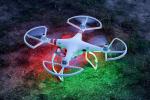H2020 SENSOILS Project: Detection of soil processes to improve nitrogen bioavailability in crops
- Type Project
- Status Filled
- Execution 2015 -2022
- Assigned Budget 1.978.475,00 €
- Scope Europeo
- Main source of financing Horizon 2020
- Project website SENSOILS
We developed a new generation of artificial soils capable of reporting on the nature of chemical changes occurring in the soil due to biological activity, using a common, low-refractive-index plastic and introducing functionalities through a thin layer of functional material. For the particle core, we used FEP (fluorinated ethylene propylene), and the project has successfully identified and synthesized polymers with functions suitable for use in artificial soils. We have developed a novel microscopy and pipeline platform for the fabrication of microcosm chambers where microorganisms, nutrients, and other additives can be flexibly introduced and visualized, in vivo and in situ. We have also made key advances in the development of computational techniques, proposing the first whole-organ model to simulate morphogenesis at cellular resolution.
Thanks to these new technologies, we were able to track the behavior of soil microbes during rhizosphere colonization. With our novel live imaging systems, we have revealed the astonishing level of coordination that soil bacteria employ to navigate the soil structure and colonize the host plant. We showed that bacterial cells move in flocks, similar to how it is typically observed in more complex higher organisms, such as birds and fish. We also showed that these movements are made possible by the bacteria's ability to create localized, yet constant, laminar flows of water through the soil, thus moving as a group rather than individually.
The project has resulted in several notable publications in journals such as PNAS, New Phytologist, and ISME Journal, with other publications still under review in high-impact journals. The project has also provided a significant boost to scientific development, with numerous follow-up projects funded nationally and internationally. Other outcomes include publications in national journals, social media, and early career scientists at various research institutions around the world.
The yield of the crops that currently sustain the world's population is heavily dependent on agrochemicals (e.g., N/P/K fertilizers and pesticides) and modern crop varieties (e.g., dwarf wheat varieties) developed in the late 20th century at the expense of soil health. As part of the "Farm to Fork" strategy, the European Commission aims to reduce nutrient losses by at least 50% by 2030, a 20% reduction in fertilizer use, and simultaneously improve soil quality. To address this challenge, there is an urgent need to identify sustainable solutions for soil fertility and crop yield based on an understanding of soil microbial processes.
In the SENSOIL project, we have tested radical new ideas for studying the dynamics of roots and soil microbes. Research has shown that, by inventing artificial soils and imaging technologies, it is possible to track microbial interactions and associations with crop roots, while also observing changes in soil chemical composition. Using these new technologies, the project revealed new forms of bacterial movement, indicating that migrations in soil could be faster and more extensive than previously estimated, but also revealing how these processes become sensitive to changes in soil properties. Discoveries from the SENSOIL project could have a major impact on our understanding of the soil ecosystem, while helping the agritech industry develop more sustainable solutions.
Food production relies on the application of nitrogen fertilizers, which can contribute significantly to greenhouse gas emissions and the eutrophication of agroecosystems. Therefore, it is necessary to optimize the use of nitrogen fertilizers.
The recent development of transparent soils in my group offers extensive scope for understanding the processes involved in reactive nutrient transport in the soil and its interaction with soil biota. My team will combine principles of optics, chemical engineering, physics, chemistry, soil biology, and plant biology to visualize and characterize nitrogen movement in the soil at the microscale. We will develop a new generation of transparent soil analogs that measure the biological and chemical state of soils. This will allow, for the first time, to characterize transport at the surface of soil particles and to elucidate the role of root-particle-particle contacts, exudation, and microbial transformation in the bioavailability of nitrate and ammonium.
The legacy of this research will be knowledge, concepts, soil model systems, and imaging approaches to understand and predict nutrient bioavailability in soil, with an emphasis on nitrification as a model for nitrogen movement in soil. Transparent soils and imaging technologies will be patented, potentially paving the way for 3D chemical sensors and having applications in crop improvement and precision phenotyping. Understanding nutrient movements in soil will lead to substantial progress in the development of more efficient fertilizers. New soil model systems could be used to better understand the spread of soil-borne diseases, the bioremediation of contaminated soils, and the mechanisms underlying soil biodiversity and activity.
Four main areas of the project have significantly advanced the field and transcended the national level.
First, the development of core-shell structure technologies to create responsive soil particles or "responsive soils." These will have a wide range of applications, for example, in scientific research, cultivation, and fertilizer development. This has required significant advances in polymer science, and the techniques could be used in other areas of science and technology.
Our work is making a significant contribution to the field of soil microscopy. We have developed several approaches that allow for live observation of soil microbes. We are developing novel fluidic systems for monitoring soil conditions under a microscope.
Computational modeling work for simulating root development in soil is extremely promising. We anticipate that it will be possible to perform full-root simulations at cellular resolution while simultaneously modeling the soil at the particle level. The model and algorithms are being implemented in DualSPHysics, an open-source community simulation tool.
Work focused on understanding the factors that affect microbial activity in the rhizosphere is, and is just beginning to, benefit from the project's technological development. In particular, we hope to be able to precisely quantify the mobility coefficient of soil microbes surrounding plant roots and predict what contributes to the maintenance of certain microbes in the rhizosphere.
- NEIKER-INSTITUTO VASCO DE INVESTIGACION Y DESARROLLO AGRARIO SA (NEIKER)






